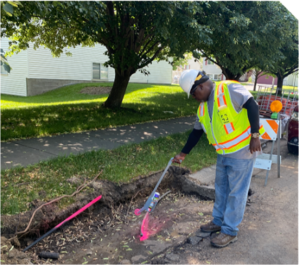When It Comes to Asset Management, What Should Small Communities Be Doing?
By Jeannine Clancy and Doug Fischer

In 2022, the American Society of Civil Engineers (ASCE) released a report card for Minnesota’s infrastructure, in which Minnesota received an overall grade of “C.” Of particular interest to Minnesota cities are the ratings for assets typically owned by local government, which received the following scores:
- Drinking water: C-
- Roads: D+
- Bridges: C
- Wastewater: C
- Public parks: B-
Missing from the report card was an evaluation of our stormwater systems, which have been put to the test by extreme weather events that are occurring more frequently.
Do you know what the scores are for your community?
Minnesota’s small communities are responsible for operating and maintaining infrastructure that is key to public health and the protection of the environment. To ensure infrastructure is properly maintained, effective asset management planning is essential. At its core, asset management is a process for maintaining a desired level of customer service at the best cost.
While the commitment to set aside the time and resources may seem intimidating and difficult, it does not have to be overly expensive or time intensive. You do not need to buy special or expensive software either. The American Waterworks Association (AWWA) and the American Public Works Association (APWA) are professional associations that have developed guidance for how agencies can conduct asset management planning. Here are some strategies that both organizations recommend adopting to make the task less daunting.

What do we have, what is it worth, and what condition is it in? Creating an inventory of what your community owns can be done on a spreadsheet or using geographic information systems (GIS), which combines a mapping tool with the database. It is helpful to document when the infrastructure was built, if there have been any renewal projects, what condition the asset is in, and an estimate of its remaining useful life. This task requires input from city staff representing parks, public works, finance, and the city clerk’s office.
What do we need to do? The next step is to have discussions about level of service. These discussions are foundational to the asset management plan because the level of service will document expectations from the community and regulators. During these discussions, talk about where the city might be achieving the level of service and where it might be falling short.
When do we need to do it and how much will it cost? Once the level of service is articulated, it’s important to discuss business risks. These discussions include identifying assets that are most important to the city from a public health and safety perspective and thinking about what would happen if there was asset failure. How does the community recover from asset failure? City staff and elected officials should work together in developing a level of service and having business risk discussions.
Information is the catalyst for change
When provided with inadequate information, decision makers may do nothing. However, with an inventory of assets, a level of service defined, and the risks identified, they can develop a capital improvement investment strategy that works for the community. Defining a strategy will help prioritize the community’s needs so critical work gets done first. It will also help to identify any funding gaps looming for major infrastructure investments. There are numerous funding programs available, and small communities can dramatically increase their odds of maximizing grant and low-interest loan opportunities if they plan. Additionally, it is common for funding applications to require documentation for the need of a project. An asset management program can fulfill this requirement.
Bridges, roads, parks, and water and wastewater systems are commonly taken for granted, but it will be immediately noticed if they are not working to the levels that have come to be expected. These infrastructure assets affect our quality of life regardless of whether those assets are managed at the municipal, county, state, or federal levels. Leaders have a duty to operate and maintain these systems effectively and cost efficiently. Having an effective asset management system is one tool to help fulfill this critical role.
Jeannine Clancy and Doug Fischer work at TKDA and serve cities (www.tkda.com). TKDA is a member of the League’s Business Leadership Council (lmc.org/sponsors).

